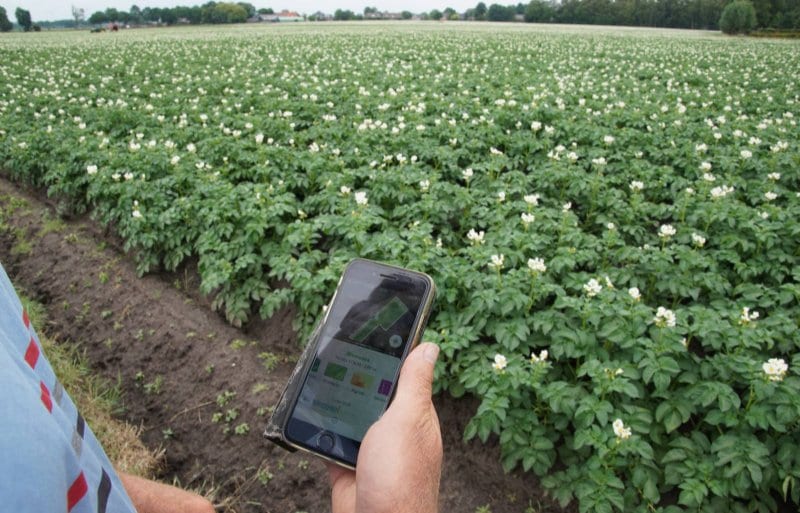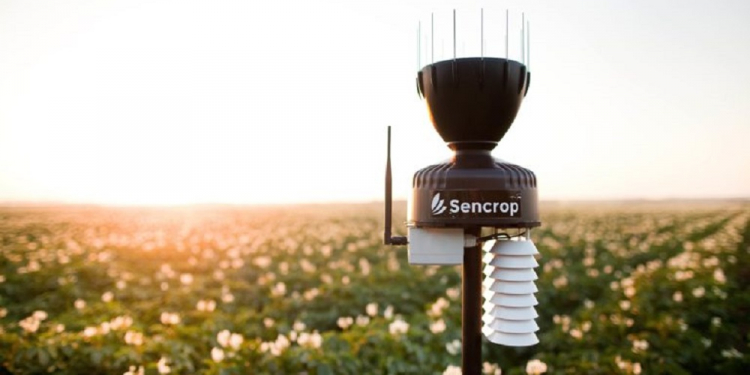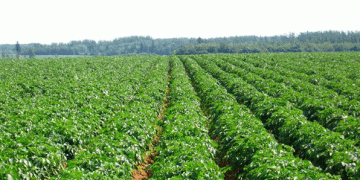In the space of five years, Sencrop has grown into a major supplier of weather stations for so-called connected networks in Europe. The weather stations provide local and accurate weather data. By sharing this data within a local network, growers and their advisors have valuable information to optimize crop management. The 20,000th weather station was installed this month.
Agro-weather network
Five years ago, Sencrop started as a technology start-up by setting up an agro-weather network. A network consisting of weather stations that locally collect data on, among other things, temperature, humidity, wind speed and cumulative rainfall. Within the network, the data from the individual weather stations is shared with each other. This provides valuable weather data with which participating growers can optimize their management. It supports the growers in determining the right moment for sowing, irrigating or spraying, for example. This method fits in a sector that is making the switch to precision agriculture. This explains the growing interest in real-time accurate weather data.
International approach
The development of the company weather stations was in France, but the company has opted for an international approach. In 2017, the Netherlands, together with Belgium and the Czech Republic, was the first country outside France to discover the innovative weather stations. In the spring of 2020, the milestone of 10,000 stations was reached. Just one year later, in June 2021, the network of stations has doubled again. The 20,000th station is located in Lower Saxony.
From French start-up to European market leader
At the end of 2019, company was present in 14 European countries and South Africa. Thanks to an international team of 11 nationalities, Sencrop weather stations are now available in thirty countries around the world. Sencrop is currently the market leader in Europe.
“When we created Sencrop, we wanted to contribute to the development of a more sustainable and efficient agriculture. Five years later, we are pleased to see that our application is now used by 18,500 farmers. Half of these are also part of a private network that enables collaboration between growers in the same area.” According to Martin Ducroquet and Michael Bruniaux, co-founders of Sencrop.“

Potato: Case Study
The weather plays a major role in the cultivation of potatoes. Sencrop indicators make it possible to gain in precision when processing plots.
- Organization of plain tours
- Prevention of diseases and risks
- Savings on inputs
Detecting the risks associated with potatoes
Sencrop provides precision meteorological data for the potato crop to prevent disease and optimize decisions about treatment windows.
- Mildew – A fungal disease, late blight can wreak havoc in potato crops. The Mileos decision-making tool makes it possible to identify and prevent this risk.
- Alternaria – Alternaria blight is favored by the alternation of dry and wet periods and by stress affecting crops (drought, nutritional deficiency, etc.).
- Pests – Colorado potato beetles, aphids and black slugs are particularly fond of potatoes. Against them, it is essential to deal at the right time.
- Dartrosis – This fungal disease attacks both tubers and aerial parts of the plant. It is favored by high temperatures.
- Rhizoctonia – Rhizoctonia causes various damage to potato crops at various stages of the growing cycle.
- Weeds – These competing potato plants reduce the quantity and quality of production. It is essential to find the appropriate intervention window.
Downy mildew: a disease of the potato
As the potato crop is particularly at risk, Sencrop offers a solution for monitoring weather data as well as a link to OAD Mileos with your application, in order to detect risk factors and anticipate treatment windows. Caused by the fungus Phytophthora infestans, late blight is a disease capable of causing considerable damage to crops. Major symptoms: late blight is characterized by oily, discolored spots appearing on the top of the leaves. These spots are brown on the petioles, stems and tubers.

Yield loss can reach 80% of the harvest, or even 100% in the most severe cases. The alternation of periods with high humidity and quite hot favors its development.
Sencrop’s connected rain gauges detect weather conditions favorable to the appearance of late blight in plots dedicated to growing potatoes. This disease is favored by the succession of heavy rains (humidity greater than 90%) and fairly hot periods (average temperature above 11 ° C). The presence of water on the leaves initiates the germination of late blight oospores, which leads to infection. To prevent this risk, you benefit from precise measurements concerning humidity, point and average temperature, and rainfall.
Source: Sencrop






